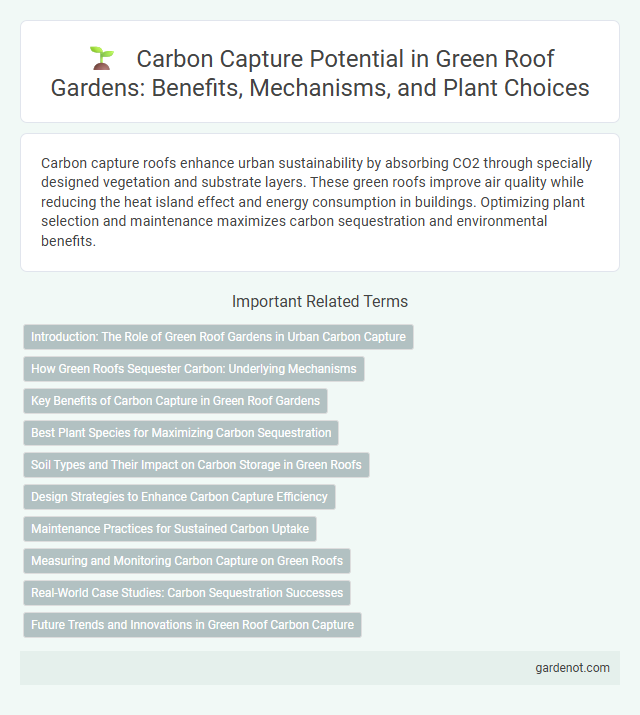Carbon capture roofs enhance urban sustainability by absorbing CO2 through specially designed vegetation and substrate layers. These green roofs improve air quality while reducing the heat island effect and energy consumption in buildings. Optimizing plant selection and maintenance maximizes carbon sequestration and environmental benefits.
Introduction: The Role of Green Roof Gardens in Urban Carbon Capture
Green roof gardens significantly enhance urban carbon capture by absorbing atmospheric CO2 through plant photosynthesis, thereby reducing greenhouse gas concentrations. These living roofs increase urban biodiversity and improve air quality while simultaneously mitigating heat island effects. Integrating diverse plant species on green roofs maximizes carbon sequestration, contributing to climate change mitigation in densely populated cities.
How Green Roofs Sequester Carbon: Underlying Mechanisms
Green roofs sequester carbon primarily through the process of photosynthesis, where vegetation absorbs CO2 and converts it into organic carbon stored in plant biomass and soil. The substrate layer beneath the plants acts as a carbon sink, trapping stable soil organic matter and reducing carbon release. Root systems also enhance microbial activity that promotes soil carbon stabilization, contributing to long-term carbon capture on green roof systems.
Key Benefits of Carbon Capture in Green Roof Gardens
Carbon capture roofs in green roof gardens significantly reduce atmospheric CO2 levels by absorbing carbon dioxide through plant biomass and soil microbial activity. These roofs improve urban air quality, mitigate climate change effects, and enhance building energy efficiency by providing natural insulation. Furthermore, carbon sequestration in green roofs supports biodiversity and promotes sustainable urban development.
Best Plant Species for Maximizing Carbon Sequestration
Succulent plants like Sedum and Sempervivum are highly efficient for carbon capture on green roofs due to their high photosynthetic rates and drought tolerance, which ensure year-round carbon sequestration. Native grasses such as Festuca and Deschampsia maximize carbon storage through extensive root systems that enhance soil organic carbon content. Incorporating fast-growing species like Miscanthus and switchgrass further increases carbon uptake, making them ideal for green roofs focused on maximizing carbon sequestration.
Soil Types and Their Impact on Carbon Storage in Green Roofs
Soil types in green roofs significantly influence carbon capture efficiency, with organic-rich and loamy soils exhibiting higher carbon storage capabilities compared to sandy or mineral soils. The enhanced microbial activity and soil structure in these substrates promote greater carbon sequestration by stabilizing organic matter and preventing carbon loss. Selecting appropriate soil types tailored to specific environmental conditions optimizes the carbon capture potential of green roof systems.
Design Strategies to Enhance Carbon Capture Efficiency
Incorporating diverse, fast-growing native plant species maximizes photosynthesis and accelerates carbon sequestration on green roofs. Utilizing vernal pools and biochar amendments in the substrate improves soil microbial activity, enhancing carbon storage capacity. Designing multilayered vegetation structures with deep-rooted perennials optimizes CO2 absorption and retention over extended periods.
Maintenance Practices for Sustained Carbon Uptake
Regular inspection and nutrient replenishment are essential for maintaining optimal plant health on carbon capture green roofs, directly enhancing their carbon sequestration capacity. Implementing efficient irrigation schedules prevents water stress and promotes continuous biomass growth, which is critical for sustained CO2 absorption. Removing invasive species and debris ensures that the vegetation remains dense and productive, maximizing long-term carbon uptake efficiency.
Measuring and Monitoring Carbon Capture on Green Roofs
Measuring and monitoring carbon capture on green roofs involves quantifying the amount of CO2 sequestered by vegetation and soil substrates using gas flux chambers and remote sensing technology. Data collection includes analyzing plant biomass growth, soil organic carbon content, and microbial activity to assess carbon storage efficiency over time. Advanced sensor networks provide real-time monitoring, enabling precise evaluation of green roof contributions to urban carbon mitigation strategies.
Real-World Case Studies: Carbon Sequestration Successes
Real-world case studies demonstrate that carbon capture roofs significantly enhance urban carbon sequestration, with installations in cities like Chicago and Berlin showing reductions of up to 25% in CO2 emissions. Intensive green roofs utilizing diverse plant species and deep substrates optimize carbon storage by promoting photosynthesis and soil microbial activity. Long-term monitoring confirms these roofs contribute to durable carbon sinks, supporting climate mitigation efforts in metropolitan environments.
Future Trends and Innovations in Green Roof Carbon Capture
Future innovations in green roof carbon capture emphasize the integration of advanced biochar substrates and sensor-driven microclimate control systems to maximize CO2 absorption. Emerging materials such as algae-infused mats and engineered soil microbes enhance photosynthetic efficiency and carbon sequestration capacity. These technologies position green roofs as critical urban infrastructure for climate resilience and sustainable city planning.
Carbon capture roof Infographic

 gardenot.com
gardenot.com